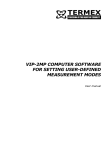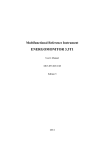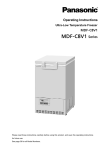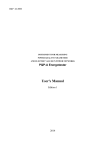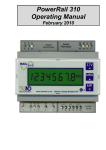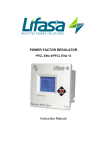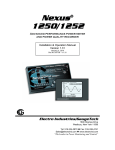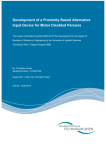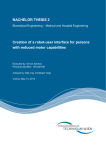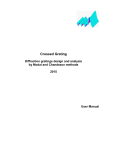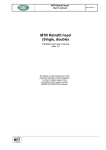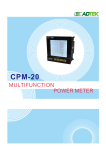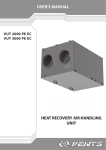Download User manual (pdf, 1401 Кб)
Transcript
МЕ48 INSTRUMENT FOR MEASURING POWER QUALITY PARAMETERS AND ELECTRICAL PARAMETERS IN POWER NETWORKS PQP Energotester User's Manual MC2.725.003 UM 2009 MARS-ENERGO CONTENTS INTRODUCTION ....................................................................................................... 4 1 SAFETY REQUIREMENTS .................................................................................. 5 2 GENERAL ................................................................................................................ 6 2.1 SCOPE OF APPLICATION ......................................................................................... 6 2.2 OPERATING CONDITIONS ....................................................................................... 6 2.3 CONTENTS OF PQP ENERGOTESTER DELIVERY PACKAGE ..................................... 7 2.4 SPECIFICATIONS .................................................................................................... 8 2.5. DESIGN AND OPERATION .................................................................................... 13 3 PUTTING INTO OPERATION ........................................................................... 15 3.1. OPERATING RESTRICTIONS ................................................................................. 15 3.2 UNPACKING ........................................................................................................ 15 3.3 PREPARING FOR OPERATION ................................................................................ 16 3.3.1 Controls and Connectors ......................................................................... 16 3.3.2 Turning on/off........................................................................................... 18 4. OPERATION ......................................................................................................... 20 4.1 OPERATOR INTERFACE........................................................................................ 20 4.2 MEASUREMENTS ................................................................................................. 21 4.2.2 Measuring power...................................................................................... 25 4.2.3 Measuring phase angles........................................................................... 30 4.2.4 Measuring harmonics............................................................................... 31 4.2.5 Waveforms ................................................................................................ 33 4.2.5 “Averaging” mode ................................................................................... 34 4.3 LOGGING ............................................................................................................ 36 4.3.1 Introduction .............................................................................................. 36 4.3.2 Logging..................................................................................................... 38 4.3.4 Current PQP values ................................................................................. 43 4.4 SETTINGS ............................................................................................................ 49 4.4.1 Access levels ............................................................................................. 49 4.4.2 Circuit connections .................................................................................. 50 4.4.3 Measuring range selection ....................................................................... 51 4.4.4 Display backlight...................................................................................... 51 4.4.5 Language .................................................................................................. 52 4.4.6 NPL and UPL correction ......................................................................... 52 4.4.7 Clock setting ............................................................................................. 53 4.4.8 Password .................................................................................................. 54 4.4.9 Memory..................................................................................................... 55 4.4.10 Bluetooth ................................................................................................ 56 4.5 DATA EXCHANGE ................................................................................................ 56 5 USER MAINTENANCE........................................................................................ 57 2 MC2.725.003 UM 6 STORAGE .............................................................................................................. 58 7 TRANSPORTATION ............................................................................................ 59 8 MARKING AND SEALING ................................................................................. 60 9 WARRANTY .......................................................................................................... 61 10 PACKING FORM................................................................................................ 63 11 ACCEPTANCE FORM....................................................................................... 63 12 WARRANTY CLAIM ......................................................................................... 64 13 CALIBRATION PROCEDURE......................................................................... 65 APPENDIX А CONNECTING CURRENT CLAMPS TO THE PQP ENERGOTESTER................................................................................................ 66 APPENDIX B CONNECTION SCHEMATICS.................................................... 74 3 MARS-ENERGO Introduction The User's Manual (“the UM” below) covers PQP Energotester instrument designed to measure power quality parameters and electrical parameters in power networks and hereinafter referred to as “PQP Energotester”, “Energotester”, or the Device. The UM describes its operation, maintenance, transportation, storage, and manufacturer's warranty conditions. The UM also includes information about the calibration procedure, packing form and acceptance form. PQP Energotester comes in two design versions: “PQP-03 Energotester” and “PQP-06 Energotester”. PQP-03 Energotester has three channels for direct phase (phase-to-phase) voltage measurements and no channels for measuring current. PQP-06 Energotester has three channels for direct phase (phase-to-phase) voltage measurements and three channels for measurement of current via current converters (current clamps included in the delivery package). PQP-06 Energotester is supplied with the current converters of different types. PQP-06 Energotester is manufactured in different design versions, metrological characteristics of each version are determined by the type of current converters (see Table 2.3): - PQP-06-0.5 Energotester; - PQP-06-1.0 Energotester. Here is an example of Energotester's designation to be specified in the purchase order: Device “PQP Energotester-0Х-Х.Х” 1 2 3 1 – device name; 2 – design version: - 03 – three channels for direct phase/phase-to-phase voltage measurement; - 06 – three channels for direct phase/phase-to-phase voltage measurements and three channels for measuring current via current converters; 3 – design version with respect to metrological characteristics (for PQP-06 version, see Table 2.3). 4 MC2.725.003 UM 1 Safety requirements 1.1 When putting PQP Energotester into operation and during operation, “Interbranch Rules for Labor Safety (Safety Rules) When Operating Electrical Systems” (M, “Energoatomizdat”, RD-153-34.0-03.150-00) must be observed. The symbol ! on the Device's panel is intended to alert the user to the presence of the important operating instructions. See “Warning” and “Caution” clauses in section 3.3.2 “Turning on”. 1.2 The device is operated according to the safety requirements specified in National State Standard GOST R 52319-05 (measurement performance classes II and III, degree of protection against pollution 1, and double reinforced insulation). Protection provided by the enclosure is per National Standard (GOST) 14254 IP53. 1.3 The maximum value of phase-to-neutral voltages at the measuring inputs shall not exceed 400 V. The maximum value of line voltages between the measuring inputs shall not exceed 600 V. 5 MARS-ENERGO 2 General 2.1 Scope of application PQP Energotester provides: - Measuring and logging of basic power quality parameters (PQP), as defined by IEC 61000-4-30; - Measuring and logging of basic electrical network parameters in single- and three phase networks: RMS currents and voltages, no matter what their waveforms may be (sinusoidal or not); active, reactive and apparent electric power; - For voltage and current meters as well as active, reactive and apparent power meters: in-situ control of accuracy characteristics (performance test) and correctness of their connection to the circuit; - For single- and three-phase electric energy meters: control of meter accuracy characteristics (performance test) and correctness of their connection without breaking into current circuits; - Measurement of electric parameters in secondary circuits (load power and voltage drop), as applied to metering and billing systems. PQP Energotester can be used for: - Inspecting the enterprises involved in electric power generation or consumption (electric power audit); - Conducting test procedures established for electric power certification; - Long term monitoring and analysing the PQP (power quality parameters); - Adjustment and testing of power supply systems. 2.2 Operating conditions Environmental conditions for PQP Energotester shall be as follows: Ambient temperature, °C -20 to + 55 Relative humidity, % up to 90 at 30°C Atmospheric pressure, kPa (mm Hg) 70 to 106.7 (537–800) Energotester shall be powered from Rechargeable power supply or from mains (220 ± 5% V AC, 50 ± 5% Hz, THD ≤ 5%) via Power adapter (12.6 V, 0.8 A). On powering up Energotester, the Rechargeable power supply is charged automatically. 6 MC2.725.003 UM 2.3 Contents of PQP Energotester delivery package Particular delivery package for PQP Energotester may be agreed to contain items specified in Table 2.1. Table 2.1 Item description PQP Energotester Basic Power adapter with mains cable (220 V) (Uout = 12.6V, Iout = 0.8 ) AA type battery “Energomonitoring” software Test leads (4 colors) HB cable PC connection cable, USB interface PQP Energotester User's Manual Calibration procedure description Package Order No Qty MC2.725.003 1 MC2.087.030 1 MC4.853.029 MC2.725.003 UM MC2.725.003 CP 4 1 CD 4 1 1 1 1 1 Optional Accessories * Current clamp kit 5A Current clamp kit 10A “K-Current” cable Current clamp kit 50A Shunt 50A Current clamp kit 100A Shunt 100A Current clamp kit 500A Shunt 500A Current clamp kit 1,000A Shunt 1,000A Current clamp kit 300/3000A MC6.705.002 MC5.064.001-02 MC5.064.001-01 MC5.064.001-03 MC5.064.001 3 3 1 3 1 3 1 3 1 3 1 3 ________________ * Optional accessories (for PQP-06 Energotester only) are included in the delivery package when specified in the Supply Agreement. 7 MARS-ENERGO 2.4 Specifications 2.4.1 Voltage measurement channels are connected to the network under control directly or via scaling converters: voltage transformers, voltage dividers etc. PQP Energotester is provided with three channels for direct measurement of phase-to-neutral (phase-to-phase) voltages with nominal values: 10V (17V), 240V (415V). Current measurement channels (for PQP-06 Energotester only) are connected to the monitored circuit via scaling converters included in the delivery package (see Appendixes A and B). PQP Energotester is provided with three current measurement channels (connected to the circuits under control via scaling converters) that support measurement sub-ranges with nominal values as follows: - 5 A with current clamp kit 5 A; - 10 A with current clamp kit 10 A; - 50 A with current clamp kit 50 A; - 100 A with current clamp kit 100 A; - 300 A with flexible current clamp kit 300/3000 A; - 500 A with current clamp kit 500 A; - 1000 A with current clamp kit 1000 A; - 3000 A with flexible current clamp kit 3000 A. 2.4.2 PQP Energotester is capable of measuring, besides other parameters of electric power, the basic power quality parameters (PQP) as defined by IEC 61000-4-30. See Tables 2.2 and 2.3 for measuring ranges and permissible error limits. Monitored values are continuously measured, calculated, graphically displayed on the Device’s LCD screen, and logged for further transfer to a PC. Measured data from ADC are processed programmatically by firmware. PQP Energotester's general specifications are specified in Table 2.2. 8 MC2.725.003 UM Table 2.2 Measured parameter Measuring range Type and limit of Permissible Error Notes 1 RMS of AC voltage (U), V 0.01Un to 1.5Un relative ±[0.1+0.01((Un/U)–1)]% 2 RMS of 1st voltage harmonic (U1), V 0.01Un to1.5Un relative ±[0.2+0.02((Un/U)–1)]% 3 DC voltage (UDC), V 0.01Un to1.5Un relative ±[0.2+0.02((Un/U)–1)]% 4 Phase angle between the 1st harmonics of phase voltages, (φU), degrees 0 to 360 absolute ±0.1 0.2Un < U < 1.5Un 5 AC frequency (f), Hz 45 to 75 absolute ±0.01 0.1Un < U < 1.5Un 6 Frequency deviation (Δf), Hz -5 to +25 absolute ±0.01 0.1Un < U < 1.5Un 7 Steady-state voltage deviation (δUs), % -100 to +40 absolute ±0.2 8 Negative sequence voltage component (К2U) and Zero sequence voltage component (К0U), % 0 to 50 absolute ±0.2 9 Total Harmonic Distortion of voltage (THDU), % 0 to 49.9 10 Individual voltage harmonic ratio, n from 2 to 40 (KU(n)), % Un = 10 (17), 240 (415) V 0.1Un < U < 1.5Un absolute ±0.05 relative ±5.0 % THDU < 1.0 THDU > 1.0 0.1Un < U < 1.5Un 0 to 49.9 absolute ±0.05 relative ±5.0 % KU(n) < 1.0 KU(n) > 1.0 11 Positive sequence voltage (U1(1)), Zero sequence voltage (U0(1)) and Negative sequence voltage (U2(1)), V 0 to Un absolute ±0.002 Un V 12 Voltage dip duration (Δtdip), sec. 0.02 or longer absolute ±0.02 49 Hz< f < 51 Hz 13 Voltage dip depth (δUdip),% 10 to 100 relative 10.0 % 49 Hz< f < 51 Hz 14 Voltage swell height (Usw), in per-unit 1.10 to 7.99 relative 2.0 % 49 Hz< f < 51 Hz 15 Voltage swell duration (Δtsw), sec. 0.01 or longer absolute ±0.02 49 Hz< f < 51 Hz 16 Flicker short-term perceptibility value 0.25 to 10 relative 5.0 % 49 Hz< f < 51 Hz ∆U/U ≤ 20% provided that voltage envelope is meander-like absolute ±2.0 sec. per 24 hours Ambient temperature 10 to 35 оС 17 Reading of real-time clock — Additional specifications for PQP-06 Energotester option are given in Table 2.3. 9 MARS-ENERGO Table 2.3 Measured parameter Type and limit of Permissible Error Measuring range 1 RMS of AC current (I), A 0.05In to 1.5In relative ±[0.5+0.05((In/I) –1)]% * ±[1.0+0.05((In/I)–1)]% ** 2 RMS of 1st current harmonic (I1), A 0.05In to 1.5In 3 Phase angle between 1st voltage and 1st current harmonics in the same phase, 0 to 360 relative ±[0.5+0.05((In/I) –1)]% * ±[1.0+0.05((In/I)–1)]% ** absolute ±0.5 Notes Rated (nominal) RMS values of measured AC current are determined by and correspond to the rated values of current supported by the current converters (clampson CT) included in the delivery package, which are as follows: 5, 10, 50, 100, 300, 500, 1000, 3000 A. 0.2 In < I < 1.5In 0.2Un < U < 1.5Un (φUI), degrees 4 Active power (Р), W 5 Reactive power (Q), Var, calculated with one of the methods below: Q1=√(S2-P2), 0.01InUn to 1.5In 1.2Un 0.01InUn to 1.5In 1.2Un 7 Power factor (PF) 8 Total Harmonic Distortion of current (THDI), % 9 Individual current harmonic ratio, n from 2 to 40 (KI(n)), % ±0.5 % * ±1.0 % ** PF = 1 0.1 In < I < 1.5 In ±1.0 % * ±2.0 % ** PF 0.5L…1… 0.5C 0.1 In < I < 1.5 In ±[1.0+0.1((Pn/P) –1)]% * ±[2.0+0.1((Pn/P)–1)]% ** relative 0.01InUn to 1.5In 1.2Un -1.0 to +1.0 ±2.0 % ** ±2.0 % * relative ±4.0 % ** PF 0.86L…0…-0.86C PF 0.86C…0…-0.86L 0.1 In < I < 1.5 In ±1.0 % * ±2.0 % ** 0.1InUн to1.5In1.2Un ±2.0 % * absolute ± 0.02 * ±4.0 % ** 0.05 InUn to 0.1 InUn 0 to 49.9 ± 0.04 ** 0.05InUn to 1.5In 1.5Un 0.1 In < I < 1.5 In absolute ±0.05 relative ±5.0 % 0 to 49.9 0 to In 10 Positive sequence current (I1(1)), Zero sequence current (I0(1)) and Negative sequence current (I2(1)), A 11 Positive sequence active power (P1(1)), 0.01InUn to 1.5In Un Zero sequence active power (P0(1)) and negative sequence active power (P2(1)), W PF 0.2L…1… 0.2C 0.1 In < I < 1.5 In PF 0.45L…0…-0.45C PF 0.45C…0…-0.45L 0.1 In < I < 1.5 In ±1.0 % * Q2=UIsinφ, Q3 - method of cross-connection (for threephase networks) 6 Apparent power (S), VA relative absolute ±0.05 relative ±5.0 % absolute ±0.01 In * ±0.02 In ** absolute ±0.01Pn * ±0.02Pn ** THDI < 1.0 THDI > 1.0 0.1 In < I < 1.5 In KI(n) < 1.0 KI(n) > 1.0 0.05 In < I < 1.5 In 0.1 In < I < 1.5 In ________________ * For PQP-06-0.5 Energotester with Precision Current clamp kit. ** For PQP-06-1.0 Energotester with a basic Current clamp kit. Data not marked with asterics ( *, **) is valid regardless of PQP-06 Energotester option (equipped either with Precision or Basic Current clamp kit). 10 MC2.725.003 UM PQP Energotester provides for displaying measurement results on the graphic display, namely: - basic PQP parameters; - electrical network parameters averaged over 3 sec. averaging period. Data length for measured voltage values on the display is five significant digits and a polarity sign (represented as: ±х.хххх, ±хх.ххх, ±ххх.хх). Data length for measured values of current on the display (for PQP-06 Energotester only) is five significant digits and a polarity sign (represented as: ±х.хххх, ±хх.ххх, ±ххх.хх, ±хххх.х, ±х.хххх kA). Data length for measured values of power on the display (for PQP-06 Energotester only) is minimum four significant digits and a polarity sign (represented as: ±х.xxхх, ±хх.ххх, ±ххх.хх, ±хххх.х, ±х.хххх k). 2.4.3 Additional real-time clock inaccuracy within operating temperature range is no more than ±0.05 sec./24 hours * С0. 2.4.4 When input signal does not constitute a sine waveform, PQP Energotester still supports measurement of PQP and electrical network parameters, provided that amplitude values of current (for PQP-06 Energotester only) and voltage never exceed 150% of the nominal values for measurement sub-ranges (see section 2.4.1). 2.4.5 PQP Energotester calculates and logs the following statistic PQ data: maximum/minimum parameter values, upper/lower parameter values and number of measurements lying inside their Normal Permissible Limits (NPL) and Utmost Permissible Limits (UPL) and falling outside their NPLs and UPLs per each day (24 hours). Averaging periods are as follows: 60 sec. for steady state voltage deviation; 20 sec. for frequency deviation and 3 sec. for the other PQP). Logging capacity without rewriting is 512 days. PQP Energotester supports calculation and logging of electrical network parameters (see section. 4.3.3) averaged over 3 sec., 1 min. and 30 min. averaging periods. Logging capacity without rewriting is no less than: - 16 hours at 3 sec. averaging time; - 15 days at 1 min. averaging time (PQP values included); - 13 months at 30 min. averaging time. PQP Energotester provides for calculation and logging of magnitudes and durations of voltage dips/swells with storage capacity of up to 16000 events. PQP Energotester provides for calculation and logging of flicker short-term perceptibility values for measurement periods of 10 min. Continuous logging for 512 days is supported without rewriting. PQP Energotester logging function may operate in the “oscilloscope” mode to log data (3 phase voltages and 3 phase currents only) taken directly from the ADC at 12.8 kHz. The Device’s memory size permits such logging to last for 12 minutes without rewriting the data (or 1 hour provided that logging function for data of other types is disabled). PQP Energotester logs measurement results in its internal non-volatile memory. Data storage time is unlimited when the Device is powered off. PQP Energotester supports data transfer to a PC via serial interfaces. 2.4.6 The built-in real time clock makes it possible to record the time of data logging over all parameters measured, as they are stored in the Device's internal memory (in the Energotester's logs). Date and time setting to a new value is available. The clock is powered by a built-in battery with at least 2 years life-time. 11 MARS-ENERGO 2.4.7 PQP Energotester uses two-level protection system based on ten-digit passwords. The user gains access to a certain operation level depending on the password entered at power-up. 2.4.8 PQP Energotester remains operational when 0.5 sec. overload occurs on its measurement channels provided that RMS values of measured phase voltage never exceeds 600 V, and RMS values of measured phase currents never exceed 2In (for PQP-06 Energotester only). The Device will regain its metrological characteristics within 15 minutes after the overload removal. 2.4.9 Apparent power consumed by each voltage measurement channel is 1.0 VA or less. Input impedance per each voltage measurement channel is 0.4 MOhm as a maximum, input capacitance is 30 pF as a maximum. 2.4.10 PQP Energotester is considered set for stable operation in 30 minutes after applying power. From that point its technical characteristics are as specified in Tables 2.2, 2.3. 2.4.11 At the instant of either power supply failure or full battery discharge, the Energotester goes to “poweroff” state. The log being recorded is closed like in the standard mode. Each time a shutdown occurs in the logging mode, the Energotester automatically restarts as soon as it regains power. Then the Device resumes logging according to the parameters set before shutdown. 2.4.12 Charged to full battery, the Rechargeable power supply keeps the Device operational for at least 2 hours without mains supply (after one full charge cycle). 2.4.13 Power consumption from mains is 10 VA or less; DC power consumed by PQP Energotester itself is no more than 8 VA at 12.6 V. 2.4.14 Energotester's dimensions (height, width, depth) are within 250х120х80 mm. Energotester's weight (accessories excluded) does not exceed 1.0 kg. 2.4.15 Mean Time to First Failure (MTFF) of the Device is at least 44000 hours. Average lifetime -10 years or longer. 12 MC2.725.003 UM 2.5. Design and operation 2.5.1 PQP Energotester's block diagram is shown in Fig. 2.1. ITB– Input Transformer Block. It includes input voltage transformers (ITU, a built-in unit) and input current transformers (ITBI, available from the accessory set); ADCB – ADC Block consisting of two ADC units (voltage ADC unit ADC U and current ADC unit ADC I); DPB - Data Processing Block; FAMU, FAMI – “Former of Array” Modules. They create data arrays of voltage (U) and current (I) instantaneous values; CMRMSU, CMRMSI – Modules calculating RMS values of U and I; M P,Q,S - module calculating active, reactive and apparent power; FFTMU, FFTMI – Fast Fourier Transform Modules; DDB – Data Display Block (graphic display and keyboard); MU – Memory Unit; PCC – PC Connection unit. Fig 2.1 PQP Energotester Block Diagram 2.5.2 The Device shares basic principles of Analog-to-Digital Conversion (ADC) and the Sampling Method. In the ITB, three-phase input voltages and currents are converted into 5V level voltage signals compliant with ADC U and ADC I measuring ranges. Instantaneous signal values are converted into digital codes by six ADCs and routed to the DPB. In the DPB, the arrays of sampled instantaneous values of voltage (Uuj) and current (Uij) are created (j is the number of a sample). Programmatically calculated values of the measured parameters are shown on the Data Display, stored in the Memory Unit and may be transferred to a PC, if necessary. PQP Energotester is capable to simultaneously calculate all of the parameters of AC network: current, voltage, frequency, phase angles, individual harmonic ratios for current and voltage (n from 1 to 40), active, reactive and apparent power. 2.5.3. The Input Transformer Block includes clamps-on CT (or instrument current transformers – 3 units) each one individually calibrated (electronically compensated) to match a certain measuring channel, and three voltage dividers. The ITB relays are processor-controlled. The processor issues the commands (in the form of a potential) to switch 13 MARS-ENERGO over voltage inputs. The controller outputs the value of an active measuring range on the graphical display. The relays serve to switch among voltage measuring ranges for the input transformers. 2.5.4 The ADC Block, or Measuring Board, has six identical channels. They operate independently converting ± 5V analog input signals into 16 bit binary data (15 significant bits and 1 sign bit). Each channel is based on two chips available from Analog Device, one for input amplifier, the other for ADC itself. Type AD8675 chip, the input amplifier, matches the scaling converters due to its low output voltage drift, negligible temperature drift, and ultra-low input currents. Channel’s input impedance is over 50 MOhm. Signal taken from the amplifier is fed into type AD7656 chip, the ADC. The latter performs complete 16-bit conversion without signal quality degradation, and transmits the results in serial code to the processor upon its request. As to the entire Measuring board, it takes voltages applied to the measuring inputs, digitizes them, and passes the results onto the Processor board. 2.5.5 Data Processing Block, otherwise called the Processor board or the Controller board, exercises full control over PQP Energotester. It is responsible for making calculations over the arrays of digitized samplings, storing the results in non-volatile memory and displaying them on LCD screen, counting time, marking the intervals as per realtime clock, exchanging data with external devices (PCs), and receiving commands and data from operator’s keyboard. The Controller board bears the ultimate responsibility for smooth operation of the entire PQP Energotester. At the heart of the controller are a Texas Instruments signal processor, and an FPGA available from Xilinx. Such a solution makes possible prompt upgrading of Device’s firmware, keeping its hardware intact. Data from ADC are processed programmatically and shown on Data Display. Calculations over the sampled data are based on 4096 ADC readings taken over 0.4 sec. Thus, at 50 Hz frequency, the sampling rate of 200 samples per period is provided. Actual values are recalculated every 3 sec. 2.5.6 The Memory Unit provides storage space for measurement results, settings, etc. 2.5.7 The Power Supply Unit generates voltages for the Processor and Measuring boards 2.5.8 Graphical LCD Display and operator's membrane keyboard are both mounted on the Device's front panel and connected to the Processor Board. The keyboard is used to select operation and display modes, configure the Device etc. 14 MC2.725.003 UM 3 Putting into operation 3.1. Operating restrictions If the Device has been moved from a cold environment (with ambient temperature below -5° C) into a warm one, it shall be left to stand for at least 4 hours at room temperature before applying power, to make sure that no condensation remains inside. In case of a drop in ambient temperature for 10° C or more, the Device shall be kept for at least 30 minutes under operating conditions not connected to power. Caution! The Device shall not be used under the ingress of moisture inside its body. The contrast of LCD screen image can be impaired under the temperature below 10 ° C. However, this does not affect the Device’s performance. 3.2 Unpacking Check that the delivery package contains all parts specified in the Supply Agreement. Remove the garnish plugs and check to see if the manufacturer’s seal is intact. Should anything in the package be found damaged, contact the supplier immediately. PQP Energotester's delivery package is specified in Table 2.1. 15 MARS-ENERGO 3.3 Preparing for operation 3.3.1 Controls and Connectors Table 3.1 describes functions of the keys located on the front panel. Table 3.1 Key Name and Function 0...9 “Numeric keypad”: Press to type in numeric values ⇓⇑ “Up and down arrow keys”: Press to scroll up and down through various menu items or data fields ⇐ ⇒ “Left and right arrow keys”: Press to scroll left and right through various menu items or data fields `ENT` “Enter”: Press to activate a menu item, enter data, enable a selected mode, or insert a symbol while entering a name `ESC` “Escape”: Press to return from a mode or to leave some current menu item for an upper level menu `F` “Function”: Press to enable “Measuring range selection” mode from “Settings” menu, enter/exit “character entry” mode when typing in a site (meter) name `.` Press to turn backlight on/off PQP Energotester's upper panel is shown in Fig. 3.1. 1 2 1 – Plugholes for voltage test leads: three phases and neutral (240 V); 2 - Connector for current converters (current clamps) Fig. 3.1 Upper panel PQP Energotester's front panel is shown in Fig. 3.2. 16 MC2.725.003 UM 1 2 3 4 5 1 – Keyboard; 2 – USB port for connection to a PC; 3 – Power Supply connector; 4 – Graphic LCD display; 5 – 10V connector: phase voltages and neutral. Fig. 3.2 PQP Energotester's front and side panels 17 MARS-ENERGO 3.3.2 Turning on/off Caution! To avoid electric shock, it is strongly recommended to connect (disconnect) the Device to the measured circuits when they are de-energized. Otherwise, connection (disconnection) to the measured circuits shall be carried out by qualified service personnel in compliance with local safety regulations in force. The Device’s voltage circuits have three plugholes (Ua, Ub, Uc) for phase voltages, one more plughole UN for connection to neutral, and one connector for phase currents IA, IB, IC (for PQP-06 Energotester only). Galvanic isolation among the current circuits is provided by current clamps. The voltage circuits are symmetrical and have one common point (neutral conductor). Use manufacturer-supplied cables only. Inspect the cables. Ensure all joints are made properly to avoid overheating and excessively high resistance. Caution! The current clamps must not be connected to the DC circuits. Caution! The clips of measuring cables and current clamps shall be connected to PQP Energotester first, BEFORE being attached to the powered contacts or live conductors of the circuit to be measured. Caution! It is strongly recommended that the current clamps’ jaw faces be kept clean and free from any dirt or oxidizing, to ensure the jaws are fully closed. If there is a tight clearance between the clamped jaws, the measurement accuracy may be considerably impaired. A multitude of Energotester's connections are pictured in Appendices A and B. Power PQP Energotester from mains in the following order: 18 - Connect the “12.6 V” output of the Power Adapter to Energotester's “DC 12.6 V” input (see Fig. B-1). - Plug the mains cable of the adapter to the mains socket. - Turn on the Device by pressing “ON” button. MC2.725.003 UM Note: When Energotester is powered from the Rechargeable power supply (without mains supply), time of its continuous operation depends on the number of charge cycles. With 2700 mA*h Ni-Mh batteries, the Device is operational for at least 2 hours after one 4.5 hour charge cycle. Caution! When PQP Energotester is turned on for the first time, it is recommended to make the Device run into shutdown (to full discharge of the battery). Then use the Power Adapter to charge the battery completely until its “Charge” indicator goes out After applying power and performing self-test and initialization during a few seconds, the Device goes to the initial configuration mode. During the initialization, the performance of every unit is checked and signal processing and calculation programs are loaded (Fig. 3.3). Fig 3.3 “Loading...” screen At the conclusion of the load procedure, the Device goes to the password entry mode (Fig.4.1.1) and becomes operational immediately after entering a correct password (to ensure that its metrological characteristics are as specified in Table 2.2, the Device shall be kept powered for at least 5 minutes). The display shows: manufacturer's logo, current date and time, circuit connection type, and battery charge level in the upper line, and measuring range in the lower line. To turn off the Device, press and hold ESC key for 2 seconds while the Device is in the main menu mode. Constantly working in the “Automatic locking” mode, the Device goes to the “Password entry” screen (see section 4.1) when no button is pressed during 5 minutes. 19 MARS-ENERGO 4. Operation 4.1 Operator Interface After applying power and performing self-test, initialization and program loading procedures, Energotester goes to the password entry mode (Fig. 4.1.1). User access within the Device may be granted at two levels. The access level determines the set of options available within the “Settings” menu. Both 1st and 2nd level passwords must contain 10 digits. Fig. 4.1.1 Password entry screen The following passwords are factory preset: - 2nd level password – 2222222222 - 1st level password – 0000000000. Note: While the factory preset 1st level password is valid, it is possible to get the 1st level access by pressing `ENT` (without typing any password). Type-in the password and press “ENT” (the digits are displayed as asterisks “*”). Operator interface of the Energotester was designed on the model of nested menus. Keys `ENT`, `ESC`, ⇓, ⇑, ⇐, and ⇒ are used to navigate to a desired menu item. Location and functions of the controls and indicators are given in Fig. 3.2 and Table 3.1. Regardless of the mode, the following parameters are displayed in the top status line: current date and time, circuit connection and battery charge level (Fig. 4.1.2). The bottom status line contains: active measuring range, actual state of the logging function (in the “Logging and PQP” mode, see Fig. 4.1.3) and actual state in the `Measurements` -> `Averaging` mode. Fig. 4.1.2 Top status line Fig. 4.1.3 Bottom status line 20 MC2.725.003 UM There may be maximum six combinations of measurement ranges for current indicated as follows: - C5А, C10А, C50А, C100А, C300А, C500А, C1000А, C3000А, C5000А, if connected via current clamps of basic accuracy; - Ch5А, Ch10А, Ch1000А, if connected via precision current clamps. Voltage measurement ranges are available as 10V and 240V. Measuring range and circuit connection options are available via the “Settings” menu (see sections 4.4.2, 4.4.3). Instead, the “Measuring range selection” function may be called up promptly from no matter what menu or item, just by pressing `F` hotkey. On entering the correct password, the Device takes you to the “Main menu” window. Main menu items correspond to basic operation modes and settings. Fig. 4.1.4 Main menu Use ⇓, ⇑ keys to select an item, and `ENT` key to enter the selected mode. Note: The Device’s operator interface may be modified with respect to the order of displaying information. The changes do not affect the Device’s metrological and technical characteristics. The Device constantly works in the “Automatic locking” mode: when no button is pressed during 5 minutes, it goes to the “Password entry” screen (Fig. 4.1.1). If logging and oscilloscope modes are disabled at this time, power is removed from the Device’s analog circuits (this means that measurements are stopped ), then the Device switches to the energy saving mode. 4.2 Measurements The “Measurements” screen is shown in Fig. 4.2.1. The “Measurements” menu contains six options, the use and selection of which is dependent on user need: power; current and voltage; harmonics; phase angles; etc. Press ⇓ or ⇑ to cycle through the options. Press `ESC` to return to the main menu. 21 MARS-ENERGO Fig. 4.2.1 “Measurements” menu Except for “Waveforms”, measurement modes specified in the menu show “real time” parameters on their respective screens. On-screen data update time is 3 seconds. 4.2.1 Measuring currents and voltages In the “Currents and Voltages” measuring mode, two screens are available (Fig. 4.2.2), which are cycled with ⇐, ⇒ keys. Use `ESC` key to return to the main menu. Three-phase 4-wire connection Values displayed: RMS of phase and phase-to-phase voltages and currents; Average-rectified values of phase voltages and currents; Average values (DC component) of phase voltages. Three-phase 3-wire connection Values displayed: RMS of phase currents and RMS of phase-to-phase voltages; Average-rectified values of phase currents. Single-phase 2-wire connection Values displayed: RMS of current and voltage; Average-rectified values of current and voltage; Average value of voltage UDC (DC component). If a signal has no AC voltage component, its average voltage value UDC (DC component) equals DC voltage supplied. 22 MC2.725.003 UM Fig. 4.2.2 “Current and Voltage” screen for different circuit connections Note: Physically speaking, the effective (root mean square or RMS) values of voltage and current relate to power (heat energy) dissipated through an active load) U RMS , I RMS P = U RMS I RMS = 2 U RMS R 2 = I RMS R , where - the effective (root mean square) values of voltage and current; P - the active power dissipated through an active load; R - the active load resistance. 23 MARS-ENERGO The Device’s algorithm of RMS voltage (current) may be simplistically phrased as follows: instantaneous voltage (current) values measured by the ADC are squared and averaged, and then the square root is extracted. Average voltage (current) value is calculated from the weighted sum of voltage (current) instantaneous samples. The sign is determined by the DC component. Certain physical quantities (e.g. the magnetic force of attraction between a solenoid and a core) are proportional to the average-rectified values of voltage (current). The Device’s algorithm of Average-rectified voltage (current) value calculation may be simplistically described as averaging over the weighted sum of instantaneous samples coming from the ADC. All voltage (current) samples are considered positive. In case of DC voltage (current), its RMS, Average and Average-Rectified values are equal in magnitude. For a pure sinusoidal signal, the Average value equals zero; the RMS and Average-Rectified values are related by a constant factor. If a signal is not sinusoidal, its RMS, Average, and Average-Rectified values may differ. Let’s consider rectangular pulses with 10 V amplitude and pulse period-to-pulse duration ratio of 10. RMS voltage value for such a pulse train would be: 2 U RMS = (10V ) 10 ≈ 3.16V Average and Average-Rectified voltage values are: U av = U av − rectif = (10V ) 10 = 1V When this voltage is applied to an 1 Ohm resistor, the power be: P dissipated in the resistor would = U RMS I RMS = 3.16 * 3.16 ≈ 10W . There are a number of RMS-scaled instruments that actually measure average-rectified values of voltage (current), e.g. the instruments based on an electrodynamic measuring principle. It is important to consider that such instruments display correct values of voltage (current) only in case of a pure sinusoidal signal. Caution! The screen line showing the average values of current is informative for technical service personnel only, since the DC current component cannot pass through the input transformers and current clamps. 24 MC2.725.003 UM 4.2.2 Measuring power The “Power” mode has three options: “Active power” (Fig. 4.2.3), “Reactive power” (Fig. 4.2.4), and “Apparent power” (Fig. 4.2.5). The modes are selected with use of ⇐, ⇒ keys. Press `ESC` key to return to the main menu. Fig. 4.2.3 “Active Power” screen for different circuit connections 25 MARS-ENERGO Fig. 4.2.4 “Reactive Power” screen for different circuit connections 26 MC2.725.003 UM Fig. 4.2.5 “Apparent Power” screen for different circuit connections 27 MARS-ENERGO Three-phase 4-wire connection Values displayed: Per phase and total active, reactive and apparent power (values of reactive power may be calculated differently): - active P, - apparent S, - reactive Q = S 2 − P 2 - the geometrical method, Q = UI sin ϕ - the phase-shift method, Q = UI cos(ϕ + 90) - the cross-connection method. In addition, the screen displays the following values: per phase power factor and per phase RMS values of current and voltage. Three-phase 3-wire connection Values displayed: Total values of active, reactive and apparent power (values of reactive power may be calculated differently): - active P, - apparent S, - reactive Q = S 2 − P 2 - the geometrical method, Q = UI sin ϕ - the phase-shift method, Q = UI cos(ϕ + 90) - the cross-connection method. In addition, the screen displays the following values: total power factor, RMS of phase currents, RMS of phase-to-phase voltages. In addition, the screens display the following values: 2 summands (components) of active power and three summands of reactive power calculated by the cross-connection method. Single-phase 2-wire connection Values displayed: - active P, - apparent S, - reactive Q = S 2 − P 2 - the geometrical method, Q = UI sin ϕ - the phase-shift method. In addition, the screen displays the following values: values of power factor and RMS of current and voltage. 28 MC2.725.003 UM Note: When calculation of reactive power value follows the phase shift method, instantaneous voltage value is multiplied by instantaneous current value displaced in phase by 90°. The method of cross-connection takes the product of instantaneous value of phase current, and the instantaneous value of line voltage. In theory, if a three-phase system is symmetrical and free of non-linear distortions, the reactive power would be of the same value, regardless of the calculation method. When the symmetry is broken within the system of voltage vectors (UАВ ≠ UВС ≠ UСА), the reactive power calculated with the cross-connection method turns out different from what the other two methods give. Non-linear distortion makes the power calculated with geometrical method differ from the other two. Thus, under real conditions the three values of reactive power are never precisely the same. Regular power system is typically equipped with reactive power meters of a certain type (e.g., in Russia meters operating on the principle of cross-connection are used in three-phase systems; meters based on phase shift method are typical for singlephase systems). Caution! Each time the RMS value of voltage or current is found less than 1 % of its nominal range, the reactive power is not calculated with the phase shift method: zeroes (0) are displayed instead of a measured value. Note: For pure sinusoidal signal, active, reactive and apparent powers are computed from the formulae: P = U RMS I RMS cos ϕ , Q = U RMS I RMS sin ϕ , S = U RMS I RMS , where: U RMS , I RMS - are effective (root mean square) values of voltage and current; ϕ - is phase angle between current and voltage. Power factor can be expressed as: For a perfect sinusoidal signal PF PF = P . S =P S = U RMS I RMS cos ϕ U RMS I RMS = cos ϕ . By definition, the PF is a number between 1 and -1 (letters L or C stand for load type: L – inductive; C – capacitive, e.g. 0.52L, 0.83C, -0.92C). Although PF is directly concerned with phase angle between current and voltage, there may be a case (e.g. in the presence of severe signal distortion in a current circuit), that current and voltage curves differ from pure sine, the more PF < 1 at ϕ = 0 ( cos ϕ = 1 ). The more PF differs from cos ϕ . Power Factor is basically determined by the type of loads connected to the system (inductive or capacitive). If current lags voltage (phase angle between current and voltage is positive), the load is inductive. If current leads U ϕ I I −ϕ voltage (phase angle between current and voltage is negative), the load is capacitive. The current vector may be in one of 4 quadrants relative to the voltage vector. 29 U MARS-ENERGO U IV I III II U +P -Q +C +L -C -P -L -Q Quadrant Angle between current and voltage 0º to 90º 1st 2nd 3rd 4th Interval Active Power U RMS I RMS +P +Q -P +Q Load type Reactive Power to 0 0 to U RMS I RMS Inductive 90º to180º 0 to - U RMS I RMS U RMS I RMS to 0 Capacitive (negative) 180º to 270º (-180º to -90º) 270º to 360º (-90º to 0º) - U RMS I RMS to 0 0 to - U RMS I RMS Inductive (negative) - U RMS I RMS to 0 Capacitive 0 to U RMS I RMS Positive active power (energy) relates to energy import, negative active power (energy) corresponds to energy export. Positive reactive power (energy) indicates an inductive load with energy import, or a capacitive load with energy export. Note: To measure apparent power consumed by a current instrument transformer load , use Un=10V. 4.2.3 Measuring phase angles In the “Phase angles” mode, the display shows: phase angles between 1st voltage harmonics and phase angles between 1st voltage and current harmonics. Phase angles in degrees are put in column on the left part of the screen; the right display area shows a vector diagram. ∧ To check phase rotation for a three-phase system, make sure that angles U A(1) U B (1) ∧ U C (1) U A(1) are positive (clockwise rotation). Press `ESC` key to return to the previous mode. Fig. 4.2.6 “Phase Angles” screen for different circuit connections 30 , ∧ U B (1) U C (1) , MC2.725.003 UM In case of three-phase 4-wire or three-phase 3-wire connections, the screen displays numeric values of: phase angles between 1st harmonics of phase voltage and phase angles between 1st voltage and current harmonics per each phase. In case of single phase 2-wire circuit connection, the screen displays the phase angle between the 1st harmonics of current and voltage Caution! Each time the RMS value of voltage or current is found less than 1 % of its nominal range, no parameters in the “Phase Angles” mode are calculated. Instead, angles between voltages are displayed as ~ 90°, angles between voltages and currents are displayed as ~ 90°. 4.2.4 Measuring harmonics In the “Harmonics” mode, the following measurements are available (Fig.4.2.7, Fig.4.2.8): RMS of 1st current and voltage harmonics (U and I); THD of voltage and current (THDU and THDI); Frequency of the fundamental (1st) harmonic; Individual (each nth) voltage harmonic ratios (percentages of fundamental current; n = 1 to 40); Individual (each nth) current harmonic ratios (percentages of fundamental current; n = 1 to 40); Press `ESC` key to return to the main menu. Fig. 4.2.7 “Voltage harmonics” screens for different circuit connections 31 MARS-ENERGO Fig. 4.2.7 “Current harmonics” screens for different circuit connections Three-phase 4-wire connection: “Harmonics” mode allows the selection of 6 screens (product of 2 phase parameters (U, I) and 3 phases). Use ⇐, ⇒ keys to cycle through the screens. Three-phase 3-wire connection: 6 screens are available (product of 2 phase parameters (U, I) and 3 phases). Use ⇐, ⇒ keys to cycle through the screens. Single-phase 2-wire connection: 2 screens are available (U and I). Use ⇐, ⇒ keys to cycle through the screens. Note: Each time the RMS value of voltage or current is found less than 1 % of its nominal range, the Harmonics mode related parameters are not calculated: zeroes (0) are displayed instead of measured values. 32 MC2.725.003 UM 4.2.5 Waveforms In the “Waveforms” mode, the Device plots voltage and current waveforms on its display (Fig. 4.2.9). On entering the mode, LCD screen shows “phase A” voltage waveform. By pressing number keys `1`, `2`, `3`, `4`, `5`, `6` the user can make visible or hide other waveforms (Ua, Ub, Uc, Ia, Ib, and Ic respectively). In addition to waveforms, the screen shows RMS values of the displayed signals. Each displayed waveform/RMS couple reflects the moment of entering the mode. Press “ENT” to take another snapshot and refresh “Waveforms” screen. Press `ESC` key to return to the previous mode. Fig. 4.2.9 “Waveforms” screen 33 MARS-ENERGO 4.2.5 “Averaging” mode In the “Averaging” mode, the Device displays RMS values of current and voltage averaged over the specified interval (Fig. 4.2.11). Having selected this mode, you get to the “Averaging settings” window where you need to specify the averaging time and averaging start time (see Fig. 4.2.10). ⇓ or ⇑ keys are used to cycle through the options. To modify a value, you need to press `ENT`, key in a required value, and then press `ENT` to confirm or `ESC` to cancel the modification. To initiate an averaging session, click on `Start counting` option and press `ENT`. At this point the prompt `Start counting` turns to `Stop counting` (Fig. 4.2.10). Values will be calculated and displayed when the actual time clocked by the Device exceeds the specified `Start averaging` time. The session is indicated by the “Remaining time” status bar. The averaging period can be set with 1 min increments. Fig. 4.2.10 “Averaging” window RMS values of current and voltage averaged over a specified period (Fig. 4.2.11) are displayed with ⇐ or ⇒ keys. Use ⇐, ⇒ keys to cycle through the screens. The progress bar indicating the time remaining for an averaging cycle to complete is filled in 1 min increments. 34 MC2.725.003 UM Fig. 4.2.11 “Averaging” mode Press `ESC` key to return to the previous mode. Note: The mode is used to measure voltage drops in the line between a power meter and an instrument transformer by means of two PQP Energotesters according to the certified procedure. 35 MARS-ENERGO 4.3 Logging 4.3.1 Introduction Caution! It is recommended to delete all logs previously recorded into the internal memory in the “Memory formatting” screen (see section 4.4.9 `Memory`). Functions of measuring and viewing of power quality parameters as well as recording of measurement results and averaged values of electric quantities into the non-volatile memory (logging mode) are enabled from the “Logging and PQP” main menu option (Fig. 4.3.1). The “Logging and PQP” screen allows the user to select the following: - Current PQP values; - Logging of PQP and AVG (averaged values of electric quantities) data; - Nominal voltage and frequency (Un phase = 219.4V, Un line = 380V and Fn=50Hz are set by default); - Type of PQ limit settings (standard set for 0.38kV is set by default. ⇓ and ⇑ keys are used to cycle through the options. Press `ENT` to select a mode or `ESC` to return to the main menu. Before going to the main menu (if logging is in progress) the session is stopped upon request to confirm the termination. Fig. 4.3.1 “Logging and PQP” screen Following the list of logging settings, the screen displays the actual status of the logging mode that may be as follows: - “Waiting for start” - means that either the preset start of logging is still to come, or the Device is about to start logging and waits for next minute to begin; - “Logging” - logging in progress. To define new values of the settings, use ⇓ or ⇑ keys to put the cursor opposite to the line required and press `ENT`. This will open an editing window for the parameter. The editing function is available only in the “No logging” and “Waiting for start” modes. Should you enter 1st level password, the Device will deny access to modifying values of nominal voltage, nominal frequency and type of PQ limit settings; 2nd level password allows the user to modify all of the parameters described above. 36 MC2.725.003 UM On a startup, the Device will default to the settings specified before the last logging procedure. To change nominal values of voltage or frequency, put the cursor opposite to the selected option and press `ENT`. Use ⇐, ⇒ and number keys to enter the required values. Press “ENT” to save the new value or “ESC” to reject. Should you change setting for one of two nominal voltages (Unom.line, Unom.phase), the other will be recalculated automatically. To select the type of PQ limit settings applied to PQP measurement and calculation, put the cursor opposite to the selected option and press `ENT`. The selection window (Fig. 4.3.2) contains six options. Four of them correspond to four standard nominal voltages of the network under review, as measured at the probe connection point. Two more sets of PQ limits are customer-defined. Settings of all types are stored in the Device's memory, each one in two variant records: one is for single-phase (three phase 4-wire) circuits, the other - for three phase 3-wire circuits. Selection of a variant is made automatically according to the circuit connection type specified on the “Circuit connection” screen (see section 4.4.2). By default, the custom settings are set to 0.38 kV values. Use ⇓ or ⇑ keys to select the type of settings. Press “ENT” to activate the new set or “ESC” to reject. Either of these actions will bring up the “Logging and PQP” window. The user can create and maintain the custom NPL and UPL settings either on a PC (“Network Energomonitoring” program) or via `Settings` -> `NPL and UPL correction` (see section 4.4.6). Standard settings cannot be modified. When using instrument transformers to connect to a 0.38 kV, 6-20 kV, 35 kV, or 110-330 kV network, the Device’s nominal voltage shall be set according to voltage at the instrument transformers’ secondary windings. While using PC “Network Energomonitoring” program to process logged results of monitoring, be sure to declare the transformer(s) by entering the actual transformer ratio in an appropriate dialog box (see “Network Energomonitoring” (version 5.1or higher) User's manual for further details). Fig. 4.3.2 “NPL and UPL of PQP” selection window 37 MARS-ENERGO 4.3.2 Logging Having selected the `Logging` mode, you will see the list of logging parameters (Fig. 4.3.3) that includes the following: - Name of the object under review (to which the logged data belongs); - Start and stop time of logging (by default logging would start as it is enabled and stop that very moment a month later); - Peak load time (where start and stop times of peak loading may be selected); - PQP log zone (“free space map” function). Following this list of logging parameters the screen displays a command line prompting the user to start logging (if not turned on) or to stop logging (if in progress). Fig. 4.3.3 “Logging” window To define new values of the settings, use ⇓ or ⇑ keys to put the cursor opposite to the line required and press `ENT`. This will open an editing window for the corresponding parameter. The editing function is available only in the “No logging” mode. On confirming “Start logging” request, the Device starts to measure and calculate power quality parameters comparing them against settings (tolerances) of the selected type, and starts to measure and calculate network parameters averaged over 3 sec, 1 min, and 30 min interval (the values averaged over all of the three intervals are logged simultaneously). Power Quality parameters are calculated according to the formulae specified by IEC 61000-4-30. A logging session can be started immediately. This is indicated by `Logging` status in the bottom screen line and the session begins from an adjacent time point that is a multiple of the averaging time. Alternatively, you can define a timed start. This is indicated by `Waiting for start` message. On achieving the preset start time, `Logging`message replaces the previous one. When the stop time of a logging session is achieved, the bottom line shows `No logging` status. To request an immediate logging session, mark “Start logging” as a selected item and press “ENT”. “Waiting for start” message appears on the bottom line instead of “No logging”. A PQP logging session can be stopped at any time if required. To do this, put the cursor opposite to “Stop logging” command and press “ENT”. Press “ESC” to return to the “Logging and PQP” menu. To view “real-time” voltage and current components as they are measured (with or without logging), the user may activate the “Current PQP values” field in the “Logging and PQP” window. 38 MC2.725.003 UM By default logging starts as it is enabled and stops that very moment a month later. To edit the default values of logging parameters, put the cursor opposite to the parameter to be changed and press “ENT”. If you need to change the contents of “Object name” field, mark the field as a selected item and press “ENT”. This will display the actual list of objects (Fig. 4.3.4) that can be downloaded from a PC. Select the required name and press “ENT” to open the editing window (Fig. 4.3.5). Fig. 4.3.4 Object name selection window Fig. 4.3.5 Object name entry window To declare the name as it is on this screen, press “ENT” or “ESC”. Both keystrokes will take you back to the upper-level window (Fig. 4.3.3 in this case) with new name reflected in it exactly as you have selected. Alternatively, you may want to return with another name (corrected or replaced). In such a case position the cursor at a character to be changed with ⇐, ⇒ keys, and then press “F” key to start selection of characters. Use ⇓, ⇑, ⇐, ⇒. keys to mark a character in the table as a selected one and press “ENT” to insert the character. On doing this, the cursor will appear on the next character position of the object name. Numbers are entered by pressing number keys on the keypad. If you made a mistake typing in the name, press “F” key once again and repeat the procedure described above. Press “ENT” to save the new name or “ENT” to reject. Either of these actions will bring up the “Logging and PQP” window. Device's non-volatile memory contains 512 PQP log zones used to collect the following PQP data: number of measurements lying inside their Normal Permissible Limits (NPL) and Utmost Permissible Limits (UPL) and falling outside their NPLs and UPLs throughout a day (24 hours). Averaging periods are as follows: 60 sec for steady state 39 MARS-ENERGO voltage deviation; 20 sec for frequency deviation, and 3 sec for the other PQP. Each log zone houses a daily log. Log zones are changed automatically at the beginning of a new logging session. In the case of several logs created for one day, a new log zone is assigned to each new log. When logging lasts for several days, log zones are changed automatically each midnight. In the “PQP Log Zone” mode, there is the “free space map” function. The corresponding screen displays free zones in green, filled zones are displayed in red. The Device allows the user to simultaneously log electrical network parameters averaged over different averaging intervals: 3 sec, 1 min and 30 min (see section 4.3.3). Before starting a logging session, the user can specify “on-peak load” and “off-peak load” periods. In this case, steady-state voltage deviation will be calculated for the “On-peak load”, “Off-peak load” and “Daily” modes independently. If the on-peak (off-peak) load start and stop times are set to equal values, steady-state voltage deviation is calculated on the “daily” basis. To change “Peak load” option fields while in the “Logging” window, put the cursor accordingly and press “ENT” to open the editing window. Peak load start (stop) times are specified within 00:00 to 23:30 range in 30 min increments. In case of power shutdown, the Device will close the current log following its regular procedure. After power recovery, PQP Energotester resumes operation and restarts logging in accordance with all settings being in force before shutdown, provided that the preset logging stop time is still to come. In such a case the Device creates a new log, and goes to a new log zone (the same occurs when the user gives the command to exit and re-enter the logging mode). 4.3.3 Log formats Logged data is arranged in the following three separate blocks: - AVG log (averaged power quality parameters and averaged electrical network parameters); - PQP log; - Dips & Swells log. When logging is enabled, data of each type is separately recorded into the coresponding block (storage area). PQP storage area This storage area is used for recording PQP totals collected over an observation period. The area contains daily logs with data acquired during last 512 days. Based upon these statistics, decisions may be taken about whether power quality standards are complied with. PQP data is stored in the following format: - Type and values of settings; - Circuit connection (three-phase 4-wire, three-phase 3-wire, or single-phase 2-wire); - Voltage and frequency nominal values; - Start and stop date/time of the logging interval; - Object name; - Peak load start time (Off-peak load stop time); - Peak load stop time (Off-peak load start time); - For each power quality parameter, the statistics data is stored in the following order: - 40 Number of measurements lying inside the parameter’s NPL (Normal Permissible Limits); MC2.725.003 UM - Number of measurements lying inside the parameter’s UPL (Utmost Permissible Limits); - Number of measurements falling outside the UPL; - Maximum (Minimum) parameter value detected over the logging period (to be checked against UPL); - Upper (Lower) parameter value detected over the logging period (to be checked against NPL). Next five items in the list of statistics are not totals, but measured power quality parameters stored as described above (each parameter is averaged over 3 sec. period except for δUs (1 min. averaging) and Δf (20 sec. averaging): - Frequency deviation Δf , - Steady-state voltage deviation: phase (line) and positive sequence values taken in the daily ( δUs ), on-peak ( δU s ), and off-peak ( δU s ) modes, I II - THDU per each phase, - Negative sequence voltage ratio K 2U and zero sequence voltage ratio K 0U ; - Individual (each nth) voltage harmonic ratios K U (n ) (percentages of fundamental volt- age by phase; n= from 2 to 40). - Statistics on voltage Dips & Swells over the period of 24 hours stored in the following format: - Daily number of voltage dips for each phase and for the entire three-phase system N; - Total daily time of voltage dips for each phase and for the entire three-phase system Ttotal.; - Duration of the longest voltage dipTmax ; - Depth of the longest voltage dip δU ; - Depth of the deepest voltage dip within a day δU max ; - Duration of the deepest voltage dip T; - Daily number of voltage swells for each phase and for the entire three-phase system N; - Total daily time of voltage swells for each phase and for the entire three-phase system Ttotal. , - Duration of the longest voltage swellTmax ; - Maximum swell height Usw while in the longest swell period, relative to nominal voltage; - Largest swell height Usw max detected over the logging period of 24 hours, relative to nominal voltage; - Duration of the largest swell T; Flicker short-term perceptibility values Pst (averaged over 10 min and 2 hours) per phase within a day. The above PQP data are only available for viewing on a PC. Flicker long term perceptibility Plt taken from the arrays of flicker short term perceptibility values is calculated and viewed on a PC as well. User-oriented reports on power quality for the system under review may be written automatically. PQP data is stored in 512 log zones of the Device's non-volatile memory. PQP Energotester automatically goes to a new log zone when a logging period exceeds 24 hours or when the Device gets the command to exit and re-enter the logging mode (even if the logging period is shorter than 24 hours). The PQP log zones are used in rotation. On quiting the 512th zone, logging makes a swap for the 1st one, overriding old data. 41 MARS-ENERGO Averaged values of power quality parameters and electrical network parameters (AVG log) This storage area collects values of PQP and electrical network parameters averaged over 3 sec., 1 min., and 30 min. intervals. Logged data is stored in the following format: - RMS of AC voltages (phase, phase-to-phase); - RMS of 1st voltage harmonics (phase, phase-to-phase); - RMS of AC currents; - RMS of 1st current harmonics; - Angles between 1st harmonics of phase voltages; - Angles between 1st harmonics of phase currents; - Per phase and total powers (active, reactive and apparent). Three values of reactive power are stored, each calculated in a separate method; - Per phase and total power factors (PF); - AC frequency; - Frequency deviation; - Steady-state voltage deviation (phase, phase-to-phase and positive sequence); - Zero sequence voltage ratio and negative sequence voltage ratio; - THDU and THDI per each phase; - Positive, negative and zero sequence currents; - Positive, negative and zero sequence voltages; - Positive, negative and zero sequence active power; - Phase angle between voltage and current for positive, negative and zero sequences; - Harmonic ratios (n = 2 to 40) for voltages and currents per each phase; - Active power of n-th harmonic n = 1 to 40; - Phase angle between nth phase voltage harmonic and nth phase current harmonic (n = 2 to 40). The above data stored in the log is only available for viewing on a PC. In the PC environment, the dynamic changes in circuit parameters can be evaluated for the entire observation period. The averaged values of power quality parameters and electric network parameters are stored in the Device's non-volatile memory that is arranged as a circular buffer. One record includes all values averaged over one period. On filling the last zone, logging makes a swap for the 1st one, overriding old data. The Device provides for continious logging (before recycling the buffer) of averaged power quality and electric network parameters for the period of: - 16 hours at 3 sec. averaging time; - 15 days at 1 min. averaging time (PQP values included); - 13 months at 30 min. averaging time. Note: For example, after 16 days of continuous logging, the Device's internal memory will contain: - 3 sec-based parameters collected for the last 16 hours; - 1 sec-based parameters collected for the last 15 hours; - 30 sec-based parameters collected for the last 16 hours. Based on this data, user-oriented reports for the system under review may be created on a PC automatically. 42 MC2.725.003 UM Dips & Swells log. This storage area collects data on voltage dips and swells (otherwise called “events”). The data is stored in the following format: - Event type: dip or swell; - Phase affected by the event: A, B, or C; - Start time of the event; - Stop time of the event; - Event duration; - Relative depth (for a dip) or height (for a swell) as a percentage of the nominal voltage; - Service data. The above data are only available for viewing on a PC. Dips & Swells storage area is arranged as a circular buffer with a capacity of 16 000 events. On filling the last zone, logging makes a swap for the 1st one, overriding old data. 4.3.4 Current PQP values Selecting the “Current and PQP values” from among options of “Logging and PQP window” will take you into a set of screens (Fig. 4.3.6 - 4.3.9) linked in a chain. The ⇐, ⇒ keys are used to navigate around the screens. Press `ESC` key to return to the “Current and PQP values” mode. Currents, voltages and PQP being measured are displayed with or without logging. PQP and network parameters on the screens are updated in the intervals specified for averaging of a certain parameter: - Us , - U A(1) and δU - 1 min; Δf - 20 sec; - other parameters - 3 sec. 43 MARS-ENERGO Fig. 4.3.6 Real-time views of steady-state voltage deviation, negative and zero sequence voltage components, and frequency deviation; by circuit connection type Fig. 4.3.7 Real-time views of voltage values for positive, negative and zero sequences; by circuit connection type 44 MC2.725.003 UM Fig. 4.3.8 Real-time views of THD values and individual harmonic ratios; by circuit connection type 45 MARS-ENERGO Fig. 4.3.9 View of flicker short-term perceptibility screens for three-phase 4-wire and single-phase 2-wire configurations The ⇐, ⇒ keys are used to cycle through the screens. The available screens with displayed parameters are listed below. 46 MC2.725.003 UM Three-phase 4-wire connection: 1st screen – 1st harmonics of positive Us , negative U 2(1) and zero sequence U 0(1) voltages; - Steady-state deviation of positive sequence voltage δUs and phase voltages δU sA , - Negative sequence voltage component - Zero sequence voltage component δU sB , δU sC ; K 2U ; K 0U ; - Frequency deviation Δf ; - RMS of 1st voltage harmonics (phase, phase-to-phase). 2nd screen – Positive Us , negative U 2(1) and zero sequence U 0(1) voltages (1st harmonic); - Positive sequence current (1st harmonic) I 1(1) ; - Positive sequence current (1st harmonic) I 2 (1) ; - Zero sequence current (1st harmonic) I 0 (1) ; - RMS of 1st harmonics of phase currents; - Positive P1 , negative P2 and zero sequence P0 active power; - Phase angles between 1st harmonics of positive ϕ1UI , negative ϕ 2UI and zero sequence ϕ 0UI voltage and current; - RMS of 1st harmonics of phase currents. 3rd screen – Total harmonic distortion of voltage (THDU) by phase THDUA , THDUB , THDUC ; - Individual voltage harmonic ratios (percentages of fundamental voltage) by phase K UA(n ) , K UB (n ) , K UC ( n ) , n= 2 to 40; 4th screen – Total harmonic distortion of current (THDI) by phase THDIA , THDIB , THDIC ; - Individual current harmonic ratios (percentages of fundamental current) by phase K IA( n ) , K IB ( n ) , K IC ( n ) , n= 2 to 40; 5th screen – Flicker short-term perceptibility Pst by phase. Three-phase 3-wire connection: 1st screen – Positive, Us negative U 2 (1) and zero sequence voltages (1st harmonic); - Steady-state deviation of positive sequence voltage δUs and phase voltages δU sAB , - Negative sequence voltage component δU sBC , δU sCA ; K 2U ; 47 MARS-ENERGO - Frequency deviation Δf ; - RMS of 1st harmonics of phase-to-phase voltages. 2nd screen – Positive, Us negative U 2(1) and zero sequence voltages (1st harmonic); - Positive sequence current (1st harmonic) I 1(1) ; - Positive sequence current (1st harmonic) I 2 (1) ; - RMS of 1st harmonics of phase currents; - Positive P1 , negative P2 and zero sequence active power; - Phase angles between 1st harmonics of positive ϕ1UI , negative ϕ 2UI and zero sequence voltage and current; - RMS of 1st harmonics of phase currents. 3rd screen – Total harmonic distortion of phase-to-phase voltages THDUAB , - Individual harmonic ratios of phase-to-phase voltages THDUBC , THDUCA ; K UAB (n ) , K UBC (n ) , K UCA(n ) , n= 2 to 40; 4th screen – Total harmonic distortion of current (THDI) by phase THDIA , THDIB , THDIC ; - Individual current harmonic ratios (percentages of fundamental current) by phase K IA(n ) , K IB ( n ) , K IC ( n ) , n= 2 to 40; For three-phase 3-wire configuration, flicker short-term perceptibility Pst isnot available. Three-phase 2-wire connection: 1st screen – Positive sequence Us voltages (RMS of 1st voltage harmonics); - Steady-state voltage deviation δUs ( δU YA ); - Frequency deviation Δf . 2nd screen - Positive sequence voltage (1st harmonic) Us ; – Positive sequence I 1(1) current (RMS of 1st current harmonic); - Positive sequence active power P1 ; - Phase angle between 1st harmonics of positive ϕ1UI sequence voltage and current; - RMS of 1st harmonic of phase current. 3rd screen – Total harmonic distortion of voltage THDU ; - Individual harmonic ratios of voltage, 48 K U ( n ) n= 2 to 40. MC2.725.003 UM 4th screen – Total harmonic distortion of current THDI ; - Individual harmonic ratios of current, K I (n ) n= 2 to 40. 5th screen – Flicker short-term perceptibility Pst. To scroll through all of 40 harmonic ratios, press ⇓, ⇑ keys. Flicker short-term perceptibility is only defined for three-phase 4-wire and single-phase 2-wire connection types. In addition to the flicker short-term perceptibility value Pst, you can see on the “real-time” screen: - Flicker observation period - 10 min; - Time before the end of current flicker observation period; - Value of flicker short-term perceptibility, which is updated at the end of each 10 min flicker observation period. Flicker measurement and calculation is started upon enabling “Logging and PQP” mode, and stopped on quitting the mode. First measured Pst value appears on the “real-time” screen with 2-minute delay, as compared to the length of an observation period. Further measurements are updated at intervals equal to the time of measurement. Press “ESC” to return to the “Logging and PQP” menu. 4.4 Settings 4.4.1 Access levels The user gains access to a certain set of options available within the “Settings” menu (Fig. 4.4.1) depending on the password entered at power-up. The 1st level password gives access to the following 6 menu items: - Circuit connection; - Measuring range; - Display backlight; - Language; - Bluetooth on/off; - Password changing. When granted 2nd level access, the user can open the following 3 items in addition to the 6 listed above: - NPL and UPL correction; - Clock setting; - Memory. 49 MARS-ENERGO Fig. 4.4.1 “Settings” menu Each item of the “Settings” menu gives access to relevant options to be modified. Use ⇓ and ⇑ keys to navigate through the items. Press `ENT` to select a mode or `ESC` to return to the main menu. 4.4.2 Circuit connections “Circuit Connections” is a compulsory screen displayed after power-up (Fig. 4.1.2). However, the user may want to enter “Circuit Connections” window and declare another connection type gently, not forcing the Device power down and up. Three phase 4-wire, three phase 3-wire, and single phase 2-wire connection types are available. Typical connections to the circuits under test are pictured in Appendix B. Circuit connection type determines how the results will be calculated. The actual type of circuit connection is constantly displayed in the top status line (right corner). Note: In the three-phase 3-wire mode, there are two options to connect the Device to the current circuits: - PQP Energotester is directly connected to the phase A, B and C current circuits; - PQP Energotester is connected to А and С phases, current in B phase is set by the program. Fig. 4.4.2 “Circuit connections” menu Diagrams for connection of PQP Energotester to the circuit under test is given in Appendices A and B. 50 MC2.725.003 UM 4.4.3 Measuring range selection “Measuring Range” window is called up either by clicking on its name (specified in “Settings” upper-level menu), or by pressing “F” hot key while in any other window or menu item. As the Device is powered up, it defaults to automatic ranging of its input voltage, and to the highest possible range for its input current. Through the “Measuring Range” window, the user can manually select voltage and current measuring ranges (Fig. 4.4.3). Options for voltage are 10V and 240V. The current measuring range can be selected among C5A, C10A, C50A, C100A, C300A, C500A, C1000A, C3000A, or C5000A for basic accuracy current clamps and CH5A, CH10A, or CH1000A for precision current clamps. Select the option required with ⇓, ⇑ and `ENT` keys. Fig. 4.4.3 “Measuring range” menu Press `ESC` key to go back to the “Settings” menu. Active current and voltage measuring ranges are constantly displayed in the bottom status line (left corner). 4.4.4 Display backlight The mode is used to select the time of backlight duration (Fig. 4.4.4). Select the option required with ⇓, ⇑ and `ENT` keys. “OK” appears next to the selected option. The default value is 5 min. 51 MARS-ENERGO Fig. 4.4.4 “Display backlight” menu On selecting “Constantly” option, the backlight is turned on until the Device is powered off. Please note that the resulting increase in power consumption will affect the battery operation time, if the device is powered from a battery. Selection of “5 min” option means that the backlight will remain on for 5 seconds following the last press of any key on the Device's keyboard. The backlight can be turned off manually by pressing `.` key. Press `ESC` key to return to the “Settings” menu. 4.4.5 Language “Language” option gives the possibility to choose the language for messages and alphanumeric fields on the screens. The language is selected with ⇓, ⇑ and `ENT` keys. “OK” appears next to the selected option. Press `ESC` key to return to the “Settings” menu. Fig. 4.4.5 “Language” menu 4.4.6 NPL and UPL correction Selecting “NPL and UPL correction” from among options of the “Settings” submenu will take the user to another submenu (Fig. 4.4.6) listed below: - Correct custom 1; - Correct custom 2; 52 MC2.725.003 UM - Copy to custom 1; - Copy to custom 2. ⇓ and ⇑ keys are used to cycle through the options. Press `ENT` to select an option or `ESC` to return to the main menu. Fig.4.4.6 “NPL and UPL correction” menu Two bottom options make it possible to copy settings from any of the four standard sets of PQ limits (called “Stand. Set 1…4”) into “Custom 1” or “Custom 2”. To do this, select proper “Copy to custom” option of the above submenu. Use ⇓ or ⇑ keys to select the Standard Set as requred and press `ENT` to copy its contents into the custom set selected earlier. Then the Device will go back to the “NPL and UPL correction” window. The upper two options of the “NPL and UPL correction” submenu permit modification of “Custom 1” and “Custom 2” sets of Power Quality limits. To do this, enter the correction mode, put the cursor against the option to be modified with ⇓ or ⇑ keys and press `ENT`. In the “Enter value” mode, use the numeric keypad along with keys ⇐, ⇒, and decimal point . to key in the corrected setting. Press `.` key to alter the sign. Press “ENT” to save the new value in the memory or press “ESC” to reject. Either of the keystrokes will take you back to the “NPL and UPL correction” window. The values of the settings can be modified within the range of -50% до +50%. Caution! When entering “Custom 1” or “Custom 2” PQ limits, be sure to set each Utmost Permissible Limit strictly greater in magnitude than its corresponding Normal Permissible Limit. This implies that |UPL| > |NPL| for all time. 4.4.7 Clock setting “Clock setting” option is used to set date and time. With ⇓ or ⇑ keys put the cursor against the value to be modified and press `ENT`. Use numeric keypad along with ⇐, ⇒ keys to enter new values and press `ENT`. Then the Device will go back to the “Clock setting” menu with the new date and time on the top line of the screen. Press `ESC` key to go back to the “Settings” menu without saving changes. Press `ESC` key to return to the “Settings” menu. 53 MARS-ENERGO 4.4.8 Password You may set a new entry password, provided that its access level is equal or less to that of your current password. The procedure includes entering a new password twice each confirmed by `ENT`. Type-in a new password from the numeric keypad, and then press `ENT` (Fig. 4.4.7). If you fail to enter two identical numbers, you will be prompted to make another attempt. On accepting the new password, the Device returns to the “Settings” window. Press “ESC” to return to the “Settings” window without saving changes. Fig. 4.4.7 “Password Changing” windows 54 MC2.725.003 UM 4.4.9 Memory The “Memory” option is used to format the Device's non-volatile memory (Fig. 4.4.8) or repartition the memory among “AVG” and “Oscilloscope” logs. Select the option required with ⇓, ⇑ and `ENT` keys. Fig. 4.4.8 “Memory formatting” window While in the “Memory Formatting” window, the user is requested to confirm deletion of logs. Press “ESC” to reject formatting and return to the “Memory” submenu leaving the Device's memory intact. Fig. 4.4.9 “Memory formatting” window You can select either formatting of the entire memory or the "oscilloscope" memory only (see Fig. 4.4.9). Press the corresponding numeric key (instead of `ESC`) to start memory formatting. This procedure incorporates initialization and check on the non-volatile memory. When formatting of memory is over, the Device returns to the “Memory” submenu automatically. If formatting of the entire memory is selected, PQP Energotester delets all types of logs: daily PQP logs, AVG logs, Dips & Swells and Oscilloscope logs. 55 MARS-ENERGO Fig. 4.4.10 “Memory repartitioning” window “Memory repartitioning" window allows you to distribute the memory space among the logs as required. Press `ESC` key to return to the “Memory” window. 4.4.10 Bluetooth This item is used to enable or disable Bluetooth function to exchange data with a PC. 4.5 Data exchange There are two options that may be used to exchange data with a PC: USB and Bluetoolth. The Device supports data transfer to/from a PC regardless of its operation mode, provided that the Energomonitoring software (see “Energomonitoring software. User manual”) is installed. To provide data exchange via USB interface, the Device is connected to a PC with a USB cable. To provide data exchange via Bluetooth, it is necessary to enable the Bluetooth function both in the Device (via the menu, see section 4.4.10) and PC and establish the connection. 56 MC2.725.003 UM 5 User Maintenance 5.1 Maintenance is the care and servicing that the user provides for keeping the equipment operational over its life cycle. 5.2 Every maintenance operation shall meet safety requirements described in Sections 1 and 3.3.2. 5.3 Routine maintenance includes the following operations: - Cleaning the display and keyboard with a damp cloth; - Cleaning the oxidized contacts and checking the reliability of their fixing; - For PQP-06 Energotester, cleaning the jaw faces of current clamps with a soft damp cloth; any dirt may cause malfunction of the clamps; do not use abrasives, solvents, and alcohol. 5.4 Troubleshooting No Fault Correction 1 Energotester does not start up. Check that the batteries are inserted in the battery compartment. Power the Device from mains via Power Adapter. It is highly recommended to fully charge the batteries. Check that Power Adapter cable is reliably connected. 2 PQP Energotester spontaneously shuts down. Charge the batteries. 3 The batteries are discharged too soon. 4 There is no USB connection between the Device and PC. 5 There is no Bluetooth connection between the Device and PC. See section 3.3.2. Change the faulty batteries and fully charge the new ones following the procedure described in section 3.3.2. Check data transfer settings in the dedicated software on the computer. Check USB cable. Check that the Bluetooth function is enabled both in the Energotester and computer settings. Make sure that both the Energotester and PC are within Bluetooth coverage range. 57 MARS-ENERGO 6 Storage 6.1 PQP Energotester storage conditions shall comply with National Standard GOST 15150-69. 6.2 The Device shall be stored indoor, in a heated storeroom. Storage conditions in the manufacturer’s package: Ambient temperature from 0 to 40 °C; Relative humidity < 80% at 35 °C. Storage conditions without the package: Ambient temperature from 10 to 35 °C; Relative humidity < 80% at 25 °C. 6.3 The storeroom should be free from current-conductive dust, acid or alkali fumes and other aggressive substances. 58 MC2.725.003 UM 7 Transportation The Device should be transported packed in the manufacturer’s box. The Device can be transported in any enclosed vehicle including air-tight heated plane cargo compartment. Ambient conditions allowed during transportation: Ambient temperature - 40 °C to +50 °C; Relative humidity < 90% at 25 °C. 59 MARS-ENERGO 8 Marking and sealing 8.1 Marking The Device’s front panel bears: - Name (PQP Energotester); - Manufacturer’s trademark; - Reinforced insulation sign according to National Standard GOST R 52319-05; - Sign of Type Approval Certificate; - Conformity mark. The nameplate on the Device's rear panel bears: - Manufacturer’s name and trademark; - Device's serial number; - Date of manufacture; - Power supply type, nominal power supply voltage. 8.2 Side and face walls of the transportation box bear handling symbols: “Fragile”, “Keep dry” and “Top” 8.3 The seal is installed in the hole of a fastening screw. After opening the Device for repair, the seal should be reinstalled by the authorized Service Companies only. 60 MC2.725.003 UM 9 Warranty 9.1 The warranty terms and conditions listed below comply with applicable consumer protection laws of the Russian Federation. 9.2 All products of OOO Mars-Energo are warranted against defects in manufacture or material for a period of 2 (two) years from the date of purchase from OOO Mars-Energo. Warranty period for the batteries is 6 (six) months from the date of purchase from OOO Mars-Energo. Equipment believed to be defective may be sent within the warranty period to Mars-Energo for inspection (Warranty Claim enclosed, transportation prepaid). If the inspection by MarsEnergo confirms that the product is defective, it will be repaired or replaced (at Mars-Energo’s option) at no charge, within the underlisted limitations (paragraph 9.4), and returned prepaid to the location specified in the buyer’s Warranty Claim. All replaced parts become the property of OOO Mars-Energo. Conditions 9.3 In the event of any Device’s failure or defect in manufacture or material during the warranty period (provided that the transportation, storage and operating conditions outlined in this Manual are fulfilled), send the Device to OOO Mars-Energo along with the sales invoice or other proof of Device's ownership and date of purchase. If the documents outlined in the previous section are absent, the warranty period is calculated from the date of Device manufacture. OOO Mars-Energo retains the right to reject a warranty claim, if the documents listed in the previous section are filled out incompletely, incorrectly or illegibly. This warranty will not be applicable for the Devices whose serial number has been altered, removed or made illegible. This warranty will not be applicable for damages to your Device caused during shipment to and from MarsEnergo location. This warranty will not be applicable: 1) For parts requiring regular maintenance or replacement due to natural wear; 2) For consumable parts (parts, the nature of which is to become worn or depleted with use, such as bat- 3) For damages to the Device caused by: teries); a) Any use other than correct use described in the User manual including: - Handling the Device resulting in mechanical damages, cosmetic defects, Device modification, or damages to the LCD; - Damages caused by incorrect installation; - Damages caused by any maintenance other than correct maintenance described in the User manual; - Damages caused by installation and use inconsistent with the technical and safety standards in force in the country where the Device has been installed and used; b) Damages caused by computer virus infection or by use of software not supplied by Mars-Energo, or damages caused by incorrect software instalation; c) Damages caused by condition or defects of a system or its elements with which or as part of which the Device was used, excluding the other Mars-Energo products intended for use with the Device; d) Damages caused by accessories or ancillary equipment not made or authorised by Mars-Energo with respect to their type, condition or characteristics; 61 MARS-ENERGO e) Damages caused by repairs or attempts to repair the Device executed by an unauthorised person or company; f) Damages caused by adjustments or modifications made to the Device without prior written consent of Mars-Energo; g) Damages caused by negligent handling; h) Damages caused by accidents, fire, ingress of liquids, chemicals or other materials, flood, vibration, heat, improper ventilation, variations of supply voltage, improper power supply or input voltage, electrostatic discharge including lightning, or any other impacts or external actions beyond the reasonable control of OOO Mars-Energo and not covered by the technical documentation for the Device. The present warranty only covers hardware failures. This warranty does not cover failures of software (produced either by OOO Mars-Energo or by other manufacturers ), which are the subject of express or implied end user license agreements, separate warranties, or exclusions. 9.4 OOO Mars-Energo establishes the lifetime for the products outlined above (excluding the batteries) of 4 (four) years from the date of purchase from OOO Mars-Energo. Warranty period for the batteries is 2 (two) years from the date of purchase from OOO Mars-Energo. Please note that warranty period and lifetime differ from each other. 9.5 It is highly recommended to make a backup copy of the data from the Device's internal memory and store it on another (external) media. OOO Mars-Energo shall in no circumstances be liable for any direct or indirect damages or losses, whether incidental, consequental or otherwise, including but not limited to loss of profits, loss of use or any deletion, corruption, destruction or removal of data, disclosure of confidential information or infringement of privacy, data recovery expenses, losses arising out of interruption of commercial, production or other activities based on use or loss of use of the Device. Manufacturer’s address for warranty claims follows. OOO Mars-Energo V.O. 13 Line, 6-8, office 41H, St. Petersburg, Russia, 199034 Tel/Fax (when dialed outside Russia) +7 812 327-21-11 62 MC2.725.003 UM 10 Packing Form PQP Energotester ___________ No _____________ The aforesaid equipment has been packed by OOO Mars-Energo in compliance with the Technical Requirements in force. Packer signature: ________________ (Initials and Name) Date:____________________ 11 Acceptance Form PQP Energotester ____________No_________________ Software version _______ The aforesaid equipment has been manufactured in compliance with Technical SpecificationsTS 4220-03449976497-2008and conforms to the Technical Requirements in force. Head of Quality Control Department: ________________ (Initials and Name) Corporate Seal: Date:____________________ Date of sale __________________ Corporate Seal: ________________ (Initials and Name) 63 MARS-ENERGO 12 Warranty Claim In the event of any Device’s failure or defect in manufacture or material during the warranty period (provided that the transportation, storage and operating conditions outlined in this Manual are fulfilled), send the Device to OOO Mars-Energo along with the Warranty Claim containing the following information: Device’s model and serial number; Date of manufacture; Date of putting the Device into operation; Condition of the manufacturer’s seals (in place, destroyed, absent); Description of the failure or defect; Buyer details (Company name, address, etc., including name and phone number of whom the reply may concern). 64 MC2.725.003 UM 13 Calibration Procedure PQP Energotester _____ serial number_______ The Device’s calibration procedure shall be carried out in compliance with the calibration methods established by D.I. Mendeleev Institute for Metrology (VNIIM, Saint-Petersburg, Russia). The Device undergoes primary postmanufacture calibration, and then it is calibrated after each repair. Regular calibration is performed during operation. A period of four calendar years is considered maximum time between calibrations. Date of Calibration Type of Calibration Calibration Results Calibrator's Signature, Initials and Name 65 MARS-ENERGO Appendix А Connecting Current Clamps to the PQP Energotester The 10A Current Clamps are connected to PQP Energotester either via “C-Current” cable (MC6.705.002; see Fig. A-1), or via 10A Shunt (see Fig. A-3). This depends on what accessories are found delivered with the Device. In either case the Device’s current measuring range “C 10A” shall be set. When connecting the Device to the circuit under test via the 10A current clamps, take into account that current clamps are directional. Be sure to plug the “lead-in” wire from the Device into the “source” socket of the clamp. The “return” wire from the Device is correspondingly plugged into the “load” socket of the clamp. An arrow embossed next to the clamp sockets stands for the direction “load → source” (in other words, “lead-in wire → return wire”). Fig. A1 Connecting the 10A- or 100A- Current Clamps to PQP Energotester via “C-Current” cable 66 MC2.725.003 UM Fig. A2 Flow direction marks “source Æ load” on the 10A- and 100A-Current Clamps Fig. A3 Connecting the 10A Current Clamps to PQP Energotester via 10A Shunt 67 MARS-ENERGO The 100A Current Clamps are connected to PQP Energotester either via “C-Current” cable (MC6.705.002; see Fig. A-1), or via 100A Shunt (see Fig. A-4). This depends on what accessories are found delivered with the Device. In either case the Device’s current measuring range “C 100A” shall be set. Be sure to plug the “lead-in” wire from the Device into the “source” socket of the clamp (see Fig. A-2). The “return” wire from the Device is correspondingly plugged into the “load” socket of the clamp. An arrow embossed next to the clamp sockets stands for the direction “load → source” (in other words, “lead-in wire → return wire”). Fig. A4 Connecting the 100A Current Clamps to PQP Energotester via 100A Shunt 68 MC2.725.003 UM The 1000A Current Clamps are connected to the EМ-3.3Т either via “C-Current” cable (MC6.705.002; see Fig. A-5), or via a Shunt (see Fig. A-7, A-8). This depends on what accessories are found delivered with the Device. The 1000A Current Clamps can support both 1000A mode (if connected via 1000A Shunt) and 100A mode (if connected via 100A Shunt). Depending on the mode, the Device’s current measuring range “C 1000A” or “C 100A” shall be set. When connecting the Device to the circuit under test, take into account that current clamps are directional. Be sure to plug the “lead-in” and “return” wires from the Device into the `S1` and `S2` sockets of the clamp, respectively (see below Fig. A-6). The direction is also meaningful when jaws are clamped around the current carrying conductor. `P1` and `P1` marks on the sides of the clamps stand for “source” and “load” respectively. If the jaws are clamped correctly, the pointer shows which way the power is transmitted. Fig. A5 Connecting the 1000A Current Clamps to PQP Energotester via “C-Current” cable 69 MARS-ENERGO Fig. A6 Stenciled marks “source Æ load” on a 1000A Current Clamp Fig. A7 Connecting the 1000A Current Clamps to the EМ-3.3Т via 1000A Shunt 70 MC2.725.003 UM Fig. A8 Connecting the 1000A Current Clamps to PQP Energotester via 100A Shunt 71 MARS-ENERGO The 3000A/300A current clamps are of frameless design with flexible loops and a dual range (3000A/300A) amplifier. Use the amplifier to attach the 3000A/300A current clamps to the Device, as pictured below (Fig. A-9). Depending on the range activated in the dual range amplifier (Fig. A-10), the corresponding current measuring range “C 3000A” or “C 300A” shall be set in the Device. When connecting PQP Energotester to the circuit under test, take into account that current clamps are directional. When clamping each flexible loop around the respective network’s conductor, take into account the pointer embossed on the loop’s connector (see Fig. A-11). This pointer looks like a lateral arrow and prompts the direction “source → load”. If the loop is clamped correctly, the pointer shows which way the power is transmitted through the conductor. NOTE: To achieve the highest accuracy, be sure to keep the measuring loop’s connector in the point most distant from the current carrying conductor. Fig. A9 Connecting the 300A / 3000A Flexible Current Clamps to PQP Energotester 72 MC2.725.003 UM Fig. A10 Dual range amplifier for the 300A/3000A Flexible Current Clamps Fig. A11 Flow direction mark “source Æ load” on a 300A/3000A Flexible Current Clamp 73 MARS-ENERGO Appendix B Connection Schematics PQP Energotester supports three-phase 4-wire, three -phase 3-wire, and single-phase 2-wire measurements. Voltage signals (up to 400 V as measured phase-to-neutral) are applied to the Device’s voltage inputs via voltage test leads connected to the phases of a network under test. The measured currents are applied to the Device’s current inputs via current clamps (maximum current permissible in a particular circuit under test is determined by the type current clamps). Each current clamp kit is connected to the Device via a suitable shunt or via “C-Current” cable (MC6.705.002), as instructed in Appendix A. The Device’s measuring range should be set accordingly (C 10A, C 100A, C 300A, or C 3000A). Fig. B1 Connecting PQP Energotester to mains via power adapter 74 MC2.725.003 UM Fig. B2 Connecting PQP Energotester to a three-phase 4-wire circuit Fig. B3 Connecting PQP Energotester to a three-phase 3-wire circuit 75 MARS-ENERGO Fig. B4 Connecting PQP Energotester to a three-phase 3-wire circuit Fig. B5 Connecting PQP Energotester to a single-phase 2-wire circuit 76












































































